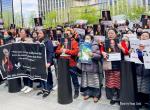– Xi Jinping, General Secretary of the CCP, 29 November 2012
When Xi Jinping spoke about his “China Dream”, “pinyin: Zhōngguómèng” a few weeks after being elected as the head of the Communist Party of China, the dream became a storm on social, print and electronic media. Xi spoke about his China Dream for the first time on 29 November 2012 while viewing the exhibition titled "The Road towards Renewal" in the National Museum of China. Post this, the dream caught everyone’s imagination and was written about for a considerable length of time post its enunciation. For most of 2013, the China Dream was discussed and debated, with even a Shanghai dialogue being held in December 2013, to commemorate its first anniversary. Lately though, it seems that the dream has lost some of its initial sheen as very little seems to be written about it. Some of this can be attributed to the fact that, initially, on account of the China Dream being ambiguous, little was known of it and hence a host of academia/specialists attempted to decipher it. Post this, the dream lost its appeal and writings on it dwindled. However in the past few years, the CPC under Xi’s guidance has taken a number of steps towards the implementation/realization of the dream and the same merit a mention. Keeping in mind this and the fact that we are approaching the third anniversary of the Dream in late November 2015, the time is now opportune to reorient ourselves with Xi’s China Dream.
Origins of the China Dream
Debates and writings on the origins of the dream have been more in number if not equal to those related to the meaning of the dream itself. The same is on account of the fact that, there has been no unanimity on the source that is deemed to have exerted the maximum influence on Xi’s China dream. While some argue that the dream is a variant of the original ‘American Dream’, others feel it was influenced by the piece written by Thomas Friedman in the New York Times and still others believe that the dream has its origins in ancient Chinese writings. What then is the truth?
Although Xi’s China Dream is a twenty first century phenomenon, some believe that its origins can be traced to ancient Chinese literature. A better understanding of the same is facilitated by Ryan Mitchell’s piece on the same subject.2 In this piece, Ryan has argued that the phrase “China Dream” was actually used about six centuries ago by the poet Zheng Sixiao while lamenting about the inability of the Southern Song Dynasty to recapture lost territory. While writing about the same, Zheng wrote the famous line “Heart full of [the] China Dream, the ancient poem ‘Flowing Spring’”. It is believed that the reference made by Zhen to the ancient poem ‘Flowing Spring’ was on account of the fact that he was heavily influenced by it. This poem can be found in the Classic of Poetry (Shi Jing) said to have been compiled by the 8th or 7th century B.C. Thus, mention of the phrase “China Dream” is found in ancient Chinese history and it does not appear to be a recent phenomenon.
Some other references to the China Dream are found in the period which symbolizes extreme anguish for most Chinese, namely, the century of humiliation (1839-1949). During the ibid period, reference to the dream was made in 1904 before the fall of the Qing Dynasty, when an extremely popular patriotic novel entitled “Dream of China's Flourishing or Failure” was published. Further, in 1915, students in a women’s college were said to have been extremely moved by a play titled “The China Dream”. Thereafter, in 1932, the publication “The Eastern Miscellany” had asked the people to write in with their "China Dream" in response to increasing and unfair treatment being meted out on China by the Japanese and Western powers.
Closer to the current century, references of the dream have been found in various literary works. A 2008 book titled “The Chinese Dream: A Society under Construction” 3 traced China’s initial period of urbanisation and brought out that China’s urbanization is highly energy dependent and inefficient. In 2010, Helen Wang wrote her book “The Chinese Dream: The Rise of the World's Largest Middle Class and What It Means to You”4 which contained more than 100 interviews of Chinese middle class people and brought out their hopes, dreams and aspirations. This book was subsequently translated into Chinese in 2011 and published in China. A large section of analysts though believe that, Xi’s China Dream is greatly influenced by Liu Mingfu, a retired PLA Senior Colonel. In his highly debated book “The China Dream: Great Power Thinking and Strategic Posture in the Post-America Era” written initially in 2010 and republished in 2015”5, Liu has argued that since the 19th Century, China has been lagging on the world stage and for the “China Dream” to come true China should be a ‘strong nation’ with a ‘strong military’. Besides this, another writer who is bestowed with the credit of popularizing and thereby influencing the China Dream is Thomas Friedman. Post Helen Wang presenting a copy of her book to him in September 2012, he came out with a piece in the New York Times in October 2012 titled “China Needs its own Dream.”6 In this piece, Friedman had argued that an American dream will not suit China and it has to have its own Chinese Dream that marries people’s expectations of prosperity with a more sustainable China. While the verdict on what/who has cast the maximum influence on Xi’s Chinese Dream is still not out, what is certain is that Xi Jinping has enunciated a unique ‘China Dream’ and the same needs to be understood.
Xi’s China Dream
According to ancient Chinese history the term "China Dream" is said to symbolise the glimpse of collective glory and the shared hope for its return. However, Xi’s China dream has been pitched at different levels ranging from individual to national and linked with different fields such as political, economic, social and military. In the face of such varied interpretations, what exactly is Xi’s China Dream about?
– Xi Jinping, General Secretary of the CCP, 19 August 2013
Over the years Chinese leaders have used catchwords/phrases to catch the attention of their people and that of the world. These phrases have also been the core ideologies which people have associated them with. Thus Mao Zedong had “Class Struggle,” Deng Xiaoping the "Four Modernizations", Jiang Zemin the “Three Represents" and Hu Jintao the “Harmonious Society". In Xi Jinping’s case, he has made the “China Dream” the ideological core of his administration.
Xi has explained his dream in the following manner "Everybody has their own ideal, pursuit and dream. Today everybody is talking about the Chinese dream. I firmly believe that, by the time the CPC celebrates its 100th anniversary, we will no doubt have achieved the goal of completely building a well-off (xiaokang) society, and by the time the People's Republic celebrates its 100th anniversary, we will become a prosperous, strong, democratic, civilized and harmonious socialist modernized country on its way to the ultimate great rejuvenation of the Chinese nation. This is the greatest dream of the Chinese nation in modern history”.8 (emphasis added)
Thus as brought out by Xi himself, the China Dream requires achieving of the “Two 100s”. The “first 100” requires China becoming a "moderately well-off society" by about 2020 (around the CPC's 100th anniversary (2021)); and the “second 100” requires accomplishment of the “modernization goal” of China becoming a fully developed nation by about 2050(around PRC’s 100th anniversary (2049)). Robert Kuhn gives us a further understanding of the two 100s when he states that "A moderately well-off society" is one where all citizens, rural and urban, enjoy decent standards of living. This includes doubling the 2010 per capita GDP by about 2020 and completing urbanization (over 1 billion people, roughly 75 percent of China's population) by 2030. "Modernization" means China re-establishing its position as a world leader in science and technology as well as in economics and business; the resurgence of Chinese civilization, culture and defensive strength; and China participating in all areas of human endeavor”. 9
Where Xi is different is that he has managed to link the dream of every Chinese with that of the nation. In essence, Xi’s China Dream encapsulates the achievement of twin goals of “reclamation of national pride” and “achieving the personal well-being of the Chinese people”. Having seen what Xi’s China Dream is, what logically follows is to see how it would be achieved?
Achieving the goal of personal well-being of the Chinese people would involve distributing the fruits of a thriving economy to one and all through sustainable development. Many have argued that as sustainable development is linked to the growth of the Chinese economy, this aspect of the China Dream would be achieved through a peaceful and harmonious process with its benefits accruing to the world at large. Their justification primarily rests on the belief that in a globalized world, a rising China attempting to realise its dream would look to enhance economic activities and hence create economic opportunities for the whole world. While this argument can be partly agreed to, the aspect which is worrying everyone is that of “the great national rejuvenation”.
When “the great national rejuvenation” takes place, China would have reclaimed its national pride and thus would have re-attained its “rightful place as the Middle Kingdom”. Hence the questions which beg to be answered are: what does China want to rejuvenate itself to? and more importantly can this national rejuvenation be undertaken in a peaceful manner? On its part, China has tried to allay fears on these count and stated that the Chinese Dream is not about recovering the country's influence in ancient times, but seeking the nation's right to live and develop. While explaining China’s view point Li Junru, former vice president of the CPC Central Committee's Party School had said “When we talk about the great rejuvenation of the Chinese nation, some people ask me which period in history, China wants to return to: The Yuan Dynasty (1271-1368) after Genghis Khan's expansion, or the heyday of the Qing Dynasty (1644-1911) before the 1840 Opium War?” He goes on to add that "It is a pure misunderstanding if it is not asked in a malicious way" and more importantly states “We put forward the concept of rejuvenation based on our historical experience that lagging behind leaves one vulnerable to attacks” 10 Despite all the Chinese attempts at justifying a peaceful rejuvenation of the nation, one realizes that, the core theme of the China Dream remains regaining past glories undone by years of colonial aggression. Against such a backdrop, the pertinent question of achieving “the great national rejuvenation” without attrition remains unanswered.
The relevance of this question is further reinforced by the fact that after the enunciation of the dream, Xi made a number of visits to military establishments. During one such visit to the Naval detachment, on board Haikou, a guided-missile destroyer that has patrolled disputed waters in the South China Sea, he said (in December 2012) that the ‘Chinese Dream can be said to be the dream of a strong nation. And for the military, it is a dream of a strong military. To achieve the great revival of the Chinese nation, we must ensure that there is unison between a prosperous country and strong military.” 11 Various articles in the Chinese media have also strongly propagated this belief with Meng Xiangqing stating in the China daily that “The centerpiece of the Chinese Dream is the rejuvenation of the Chinese nation, and a nation cannot be rejuvenated without a strong military. A backward defense force makes a country vulnerable. This is a lesson that China has learned the hard way over centuries of humiliation at the hands of imperialist powers. That is why the Chinese people have been focusing on developing the economy and, in the process, endeavoring to build a strong military.”12
While Xi’s China Dream is understood, the possibility of achieving it without attrition remains an unanswered question.
How much of the China Dream has been realized?
As nearly three years have elapsed since the dream was enunciated, an analysis of how much progress has been made towards realization of the dream would be in order. This analysis would comment on the progress made towards achievement of the twin goals of “personal well-being of the Chinese people” and “reclamation of national pride.”
To achieve the first goal China should become a moderately well off society by 2020. For this to happen, it should double its per capita GDP of 2010 by 2020 and urbanize about 75% of population by 2030. Developments on the accomplishment of this goal have been encouraging with per capita GDP in 2015 touching $3866, up from the $2626 level of 201013. Fair to say that, the doubling of the per capita GDP by 2020, appears to be well on track. The caveat here though is that, while talking of the doubling of the per capita GDP no mention of the urban-rural income inequality has been made. It is however interesting to note that, in 2013, a World Bank study had found China to be having one of the highest inequality ratios in the world14. In the face of such enormous inequality, pure doubling of per capita GDP would not suffice, along with this, reduction of the urban-rural inequality would be an absolute necessity. As far as urbanization is concerned, Xinhua claims that, by 2015, China’s urbanization rate has exceeded 50 percent. 15 Hence on both these accounts, China’s progress has been commendable. In addition, the Report on the Implementation of the 2014 Plan for National Economic and Social Development brings out a number of social development schemes which deserve credit. Noteworthy among these are 13.22 million urban jobs being created throughout the year, 366 million urban and 477 million rural residents being brought under the coverage of old-age insurance and 5.11 million government-subsidized housing units being completed. Besides these, the effort to make Regional development balanced by implementation of the "Three Major Strategies": the Silk Road Economic Belt and 21st Century Maritime Silk Road ("One Belt and One Road" strategy); the coordinated development of the Beijing-Tianjin-Hebei region; and the development of the Yangtze River economic belt are all steps in the right direction. 16 From the accomplishments thus far and keeping in mind the targets set by the recently released 2015 Draft Plan for National Economic and Social Development17, it appears that China is on its way to becoming a “moderately well off society” by 2020.
As already seen, the China Dream is intimately connected with that of a “Strong Military”. What then is the progress made towards converting the PLA into a “Strong Military”. As far as the PLA is concerned, Xi has lived up to his promise and initiated far reaching measures to modernize the PLA. The announcement by Xi during the Victory Day Parade held in September 2015 of reducing 3,00,000 personnel18 was one important initiative in that direction. In all likelihood the reductions from the PLA Army are to benefit the PLA and PLAAF, so as to readjust the present ratio between the PLA Army, PLAN And PLAAF. This reduction will also enable the PLA to enhance its operational capability. There are also indicators that structural transformation of the Military Regions is in the pipeline to reduce them from the existing seven to five/four. With far reaching military modernisation likely to happen over the next five years or more, it appears that the “Strong Military” required for the great revival of the Chinese nation is being put in place.
Another important achievement has been made in the field of Science and Technology. As per the Report on the Implementation of the 2014 Plan for National Economic and Social Development, new breakthroughs have been made in innovation. This was achieved by spending 2.09% of GDP on R&D in 2014, with corporate R&D spending accounting for over 76% of the total. On account of this cutting-edge innovations such as the Tianhe-2 supercomputer, super-hybrid rice, the Chang'e lunar lander, satellite applications and deep-sea manned submersible Jiaolong have been achieved. These accomplishments are important steps towards the “modernization” goal.
As far as reclamation of national pride goes, two strategies with aggressive contours are being employed by China. The first relates to Chinese muscle flexing in areas where there is a dispute of territorial sovereignty. Cases in point are the East and South China Seas. It is no coincidence that post 2012, Chinese tone and tenor in both these seas has become more aggressive. This is evident from the standoff with Japan over the Diaoyu/Senkaku islands in the East China Sea to include declaration of the Air Defence Identification Zone (ADIZ) over a portion of the East China Sea. Added to this is China’s policy of constructing infrastructure on reefs in the island chain of the South China Sea and claiming right to sovereignty over these islands. This construction has involved formation of artificial islands by reclaiming land through dumping of huge amounts of sand on undersea coral reefs coupled with dredging activity. The reclaimed land has been utilized for setting up infrastructure like lighthouses, helipads, surveillance facilities, small ports and a large 3000 m long airstrips. Speculation is rife that these facilities will be used for military activity.19 The second strategy relates to an increased desire by China to play the role of a global leader. This is evident from the fact that in 2012, during his visit to the US as the then Vice President of China, Xi Jinping had enunciated his concept of the “new type of great power relations” between US and China. Subsequently in 2015, during his state visit to the US, Xi proposed the “new model of major-country relationship”. Through the enunciation of these concepts both in 2012 and 2015, China has hoped to assume and be accepted as an equal player as the US on the global stage. Other strategies aimed at playing a leading role on the global stage such as the One Belt – One Road (OBOR) and Asian Infrastructure Investment Bank (AIIB) are also at play. It is no coincidence that both these strategies are backed by aggressive foreign policy.
While significant progress has been made towards realization of the China Dream till date, future progress will have to be factored against a slowing economy and an ageing population. It is well known and accepted that the realization of the China Dream is driven primarily by the Chinese economy. For the last three decades the Chinese economy has shown a phenomenal growth, however, the turmoil seen in July – August 2015 in terms of the stock-market plunge, the RMB’s moderate devaluation against the dollar and weak economic data has led to mounting pessimism about the Chinese economy. In fact a few analysts have even predicted a hard landing for the Chinese economy and thereby questioned the continued rise of China and the China Dream itself. Most of the pessimism is on account of the fact that from the heady days of two digit Chinese economic growth prior to 2010, economic growth in the years 2011 to 2014 remained between 9.3% and 7.4% and for the first time in many decades the growth slumped below 7% in 2015. In fact, the downward pressure on the Chinese economy was evident from the Chinese premier Li Keqiang’s statement at Davos in Feb 2015 when he said “that the country had entered the stage of the new normal, shifting from high speed to medium-to-high speed”. 20 This New Normal as per most analysts implies that the growth would remain in the range of 6% to 7% for the next 10 years.21The immediate question thus was whether an economy at a new normal would continue to provide the same impetus to the China Dream? Anticipating same questions, at Davos itself, Li had gone onto alleviate fears of the effect of the slowing Chinese economy on the China Dream by stating that “the new normal will not be inconsistent with the government’s goal of finishing building a moderately prosperous society”.22 This notwithstanding, it cannot be argued that a slowing economy would affect the China Dream in some way or the other sooner or later. Besides a slowing economy an ageing China is also at hand. Though to counter it the “One Child” policy has been revoked by the issue of the “Two Child” policy23, the same will take time to play out. Thus, in the coming years, it is but natural that these factors would begin to put a drag on the China Dream, the question is - in what way and by how much time?
Implications for India
Having had a relook at the dream and its progress, let us see the implications of the dream for India.
First and foremost, the China Dream is an ideology which India will do well to emulate by articulating its own “Indian Dream”. Such an “Indian Dream” should aspire to achieve the noble goal of the well-being of its people through well-articulated and quantified goals which should be measurable over laid down timelines. Though some thought to this aspect has been given, a lot more can and needs to be done.
Secondly, there is a thought that though prickly issues between the two countries remain, a win-win situation could be created for both the countries. Thus it is felt that both the countries could chase the Dream cooperatively and make it a game-changer for the holistic good of the people of the whole world and make it a ‘dream of the people’ that goes beyond borders.24 This argument is a wise one and has its merits. At the same time though, one cannot help but not lose sight of the increasing trade deficit that India faces. Trade deficit between India and China increased about 34 per cent to USD 48.43 billion in 2014-15 from USD 36.21 billion in the previous fiscal. According to provisional figures, in 2014-15, India’s exports to China stood at USD 11.95 billion while imports were USD 60.39 billion.25 Hence while trade with China is important, it is also imperative that exports be boosted to address the widening trade deficit with China.
Thirdly, while it is perfectly alright to dream of the well-being of one’s people it cannot be at the cost of sovereignty of others. A case in point is the China Pakistan Economic Corridor (CPEC). This is an important part of the OBOR, which as we have seen is integral to the China Dream. It is a well-known fact that the CPEC passes through Pakistan Occupied Kashmir (POK). In view of the same, India has rightly protested and raised observations against the same26. However, it appears that China is paying no heed to these reservations. Be that as it may, it is important that in this particular case and others too, India continues to raise its reservations against aspects of the Chinese Dream which are not in its interest.
Fourthly, it is interesting to note that some analysts also include the 1914 Simla Accord as a part of the century of humiliation. Added to this, China’s position on the Simla Accord is well known. If that be so and bearing in mind the fact that the India China border remains an unresolved issue, a question which should concern India is: Would China attempt to restore past glories on the India China border? If so, then in what way?
Fifthly, it’s a given that in the next decade the modernization of Chinese military into a “Strong Military” will unravel. Keeping this and the words of Li Junru “….lagging behind leaves one vulnerable to attacks”, in mind, it is imperative that the Chinese military modernization be kept track off as also, thoughts be spared towards the necessity of building a strong “Indian Military” which would leave us least vulnerable to any attack.
Conclusion
Signs are that China would become a “moderately well off society” by the 100th anniversary of the founding of the CPC. However, Xi’s China Dream will continue to play out much after that for the entire first half of the 21st Century. The magnitude and implications of the dream are such that the dream cannot be consigned to the sidelines. While the Chinese goal of “personal well-being of the Chinese people” is noteworthy as it strives for the betterment of the people and is in line with global aspirations, only time will be the judge of the other goal of “reclamation of national pride” and “the great national rejuvenation”.
Endnotes
- Wu Gang and Yan Shuang, “Xi Jinping pledges ‘great renewal of Chinese nation”, Global Times, Nov 2012, http://www.globaltimes.cn/content/747443.shtml
- Ryan Mitchell, “Clearing Up Some Misconceptions About Xi Jinping's "China Dream", The Huffington Post, Aug 2015, http://www.huffingtonpost.com/ryan-mitchell/clearing-up-some-misconce_b_8012152.html
- Neville Mars, Adrian Hornsby,“The Chinese Dream: A Society under Construction”, 010 Publishers, 2010
- Helen H Wang, “The Chinese Dream: The Rise of the World's Largest Middle Class and What It Means to You”, Bestseller Press, 2010
- Liu Mingfu, “The China Dream: Great Power Thinking and Strategic Posture in the Post-America Era in 2010”, CN Times, Incorporated,2015
- Thomas Friedman, “China Needs Its Own Dream”, The New York Times, 02 Oct 2012, http://www.nytimes.com/2012/10/03/opinion/friedman-china-needs-its-own-dream.html
- DS Rajan, “China: Can Xi Jinping’s “Chinese Dream” Vision be realized?”, South Asia Analysis, Paper No. 5629, 03-Jan-2013, http://www.southasiaanalysis.org/node/1436
- HaoTiechuan, “Xi Jinping's explanation of the Chinese people's dream”, China Daily (Hong Kong Edition), 16 Jan 2013, http://www.chinadaily.com.cn/hkedition/2013-01/16/content_16123041.htm
- Robert Lawrence Kuhn, “Structuring the Chinese Dream”, China Daily, 15 Jan 2014, http://usa.chinadaily.com.cn/opinion/2014-01/25/content_17257856.htm
- Mu Xuequan, “Chinese Dream is about right to develop: CPC theorist”, Xinhuanet, 12 Sep 2013, http://news.xinhuanet.com/english/china/2013-09/12/c_125379616.htm
- Ibid 7
- MengXiangqing, “Chinese Dream includes strong PLA”, China Daily, 08 Oct 2013, http://usa.chinadaily.com.cn/opinion/2013-10/08/content_17012911.htm
- China GDP per Capita, Trading Economics, 2015, http://www.tradingeconomics.com/china/gdp-per-capita
- Terry Sicular, “The Challenge of High Inequality in China”, World Bank, 2013, http://www.worldbank.org/content/dam/Worldbank/document/Poverty%20documents/Inequality-In-Focus-0813.pdf
- Huaxia, “China's 12th Five-Year Plan achievements a milestone for centenary goal”, Xinhuanet, 2015, http://news.xinhuanet.com/english/2015-10/26/c_134748390.htm
- Xinhua, “Report on China's economic, social development plan”, 19 Mar 2015, http://www.npc.gov.cn/englishnpc/Special_12_3/2015-03/19/content_1930758.htm
- Ibid 16
- Zhang Tao, “China's cut of troops wins positive comments worldwide”, China Military Online, 11 Sep 2015, http://english.chinamil.com.cn/news-channels/pla-daily-commentary/2015-09/11/content_6678425.htm
- Gopal Suri, “Rising Tensions in the South China Sea”, Vivekananda International Foundation, 21 Oct 2015, http://www.vifindia.org/article/2015/october/21/rising-tensions-in-the-south-china-sea
- AlessiaAmighini, “China’s Economic Growth. Heading to a New Normal”, ISPI Report, 2015, http://www.ispionline.it/it/EBook/CHINA.POLICY.2015/CHINA.POLICY_Cap.3_EBOOK.pdf
- Ibid Alessia Amighini
- Ibid AlessiaAmighini
- Chris Buckley, “China Ends One-Child Policy, Allowing Families Two Children”, New York Times, 29 Oct 2015, http://www.nytimes.com/2015/10/30/world/asia/china-end-one-child-policy.html?_r=0
- Amrita Jash, “Xi Jinping’s ‘Chinese Dream’ and its implications for India”, World Focus, Vol. XXXV, No. 3, March 2014, https://www.academia.edu/6963592/Xi_Jinping_s_Chinese_Dream_and_its_Implications_for_India
- The Hindu, “India-China trade deficit swells 34% to $48 billion”, 13 May 2015, http://www.thehindu.com/news/national/indiachina-trade-deficit-swells-34-to-48-billion/article7201545.ece
- Devirupa Mitra, “India Lodges Protest over Chinese Investments in PoK”, The New Indian Express, 13 May 2015, http://www.newindianexpress.com/nation/India-Lodges-Protest-over-Chinese-Investments-in-PoK/2015/05/13/article2811562.ece
Published Date: 24th November 2015, Image Source: http://www.scmp.com
(Disclaimer: The views and opinions expressed in this article are those of the author and do not necessarily reflect the official policy or position of the Vivekananda International Foundation)









Thanks
Post new comment